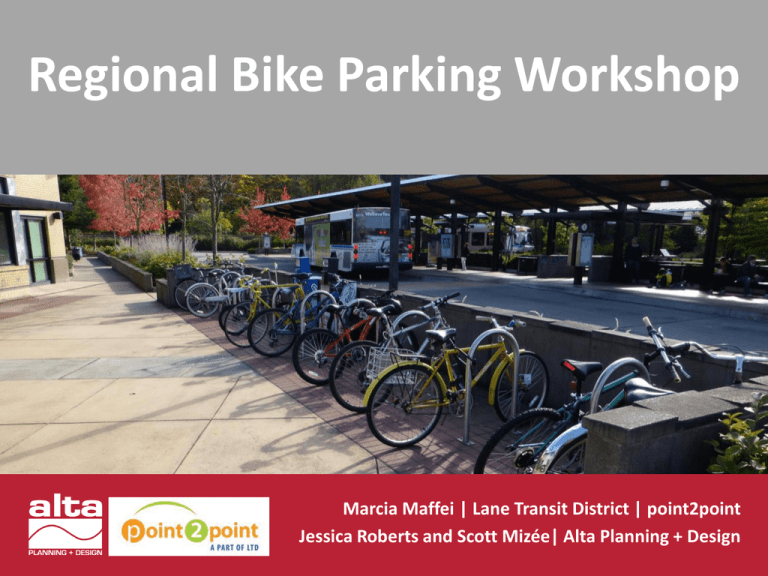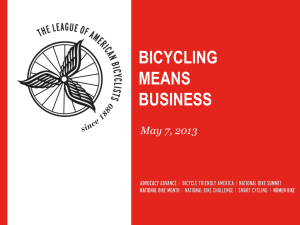Regional Bike Parking Workshop PowerPoint
advertisement

Regional Bike Parking Workshop Marcia Maffei | Lane Transit District | point2point Jessica Roberts and Scott Mizée| Alta Planning + Design Regional Bike Parking Workshop 1. 2. 3. 4. 5. 6. 7. 8. Overview of Study Learning Objectives Business Case for Bicycle Parking Life Cycle of Bike Parking in a Jurisdiction Recommended Rack Types Recommended Long-Term Parking Installation Guidelines Resources About the Study Regional Bike Parking Study Purpose: To provide the region with key planning information about: • Short and long term bicycle parking supply and demand • Concerns about existing facilities • Need for additional bike parking at transit stations in downtown • Design guidance for selecting and installing bike parking • Potential development code changes for Coburg, Springfield, and Eugene Study Area LTD Transit Stations Activity Centers Downtowns Workshop Learning Objectives 1. 2. 3. 4. 5. 6. Create shared vocabulary How is bike parking regulated and installed? What makes for good (and bad) bike parking? How to select and install bike parking? Costs of different types of bike parking Understand resources Definitions Definitions: Short-Term Definitions: Long-Term Rooms/Cages Long-Term Parking: Rooms/Cages Long-Term Parking: E-Lockers Principles of Good Bike Parking • Easy to find (near door, not hidden) • Easy to use: – Space to maneuver – Can use both sides of rack – Bike is protected and out of the way – Two points of contact for frame – Must be able to lock frame with U-lock – Ideally: shelter from elements The Case for Bike Parking Business Case for Bike Parking • Efficiency: more vehicles per space; more vehicles overall • Not all customers arrive by car • Bike customers spend more $$ • More attractive streetscape • Marketing edge for businesses Policy Benefits of Bike Parking • Support downtown/neighborhood redevelopment • Help transit (first/last mile problem) • Attract & retain employees/residents • Minimize parking/vehicle impact of infill • Support goals to reduce VMT/carbon The Life Cycle of Bike Parking Public Property Jurisdiction directly controls property, structures, fixtures Public Property What? • Identify bike parking needs • Prioritize projects Secure Funding • Ongoing • One-time Install and maintain • Install • Maintain Monitor • Changing needs • Public input Private Property • Agencies do not control directly • Mechanisms for affecting outcome: – Development code – Code enforcement – Other policies (e.g. height bonus) – Public input – Partnerships/lease agreements Private Property Review applicable policies • Development code • Installation/design guidance Work with architect/site designer • Type, quantity, manufacturer • Where on site City approval • Code enforcement Installation • Installation guidance • Code enforcement Recommended Rack Types Recommended Rack Types • Hoop and Post • Staple/Inverted U Rack • Art Rack Staple or Inverted “U” Hoop & Post Art Rack Recommended Long-Term Bicycle Parking • • • • Two-Tier Racks Wall Hanging Racks Cages/rooms Lockers Two-Tier / Double Decker Wall Hanging Cages and Rooms Attended Facilities Lockers Oversize Bikes and Trailers Rain Shelter Installation Guidelines Bicycle Parking Installation Guidelines • • • • • • • • Bicycle Lockers Secure Parking Area (SPA) or Bike Rooms On-Street Bike Corral Sidewalk Bicycle Rack Placement Racks for Non-Standard Bicycles Staple or Inverted U Bicycle Rack Wall Hanging Bicycle Rack Two-Tier/Double Decker Bicycle Racks Bike Lockers Secure Parking Area • Secure access for users with closed-circuit television monitoring. • Double-decker racks & cargo bike spaces. • Bike repair station with bench, pump, and tools. • Bike tube and maintenance item vending machine. • Bike lock “hitching post” – allows people to leave bike locks at the SPA. • Lockers for users to securely store belongings. • Electrical outlet for charging e-bikes. Sidewalk Placement • • • 2 feet minimum from the curb face to avoid ‘dooring’; 3 feet between parallel racks; 4 feet between end-to-end racks. Close to destinations; 50 foot maximum distance from main building entrance. Minimum clear distance of 6 feet should be provided between the bicycle rack and the property line. • Should be highly visible from adjacent bicycle routes • and pedestrian traffic. • Locate racks in areas that cyclists are most likely to travel. On-Street Bike Corral • • • • Bicyclists should have an entrance width from the roadway of 5 – 6 feet. Can be used with parallel or angled bike racks. Physical barriers should be installed a minimum of 6 inches from curb to allow drainage and reduce collection of debris. Parking stalls adjacent to curb extensions are good candidates for bicycle corrals since the curb extension provides a physical barrier to protect parked bicycles. “What’s Wrong with This Bike Parking?” Principles of Good Bike Parking • Easy to find (near door, not hidden) • Easy to use: – Space to maneuver – Can use both sides of rack – Bike is protected and out of the way – Two points of contact for frame – Must be able to lock frame with U-lock – Within 50’ of building entrance – Ideally: shelter from elements Resources • • • • • Best Practices Powerpoint Slideshow Visual Guide to Bicycle Parking Types Bicycle Parking Installation Guidelines Signs and Stickers Bicycle Parking Scorecard Questions and Comments? Marcia Maffei 541-682-6206 Jessica Roberts 503-230-9862 Scott Mizée 503-230-9862 Marcia.Maffei@ltd.org JessicaRoberts@altaplanning.com ScottMizee@altaplanning.com




